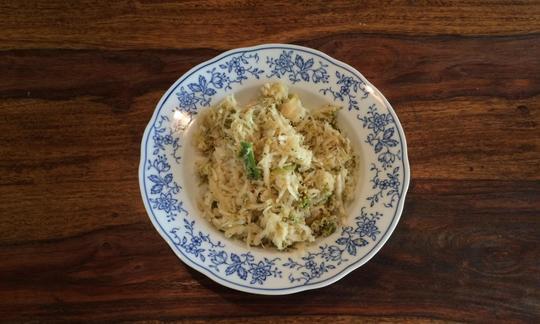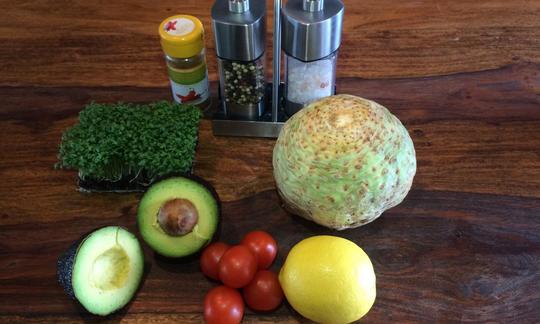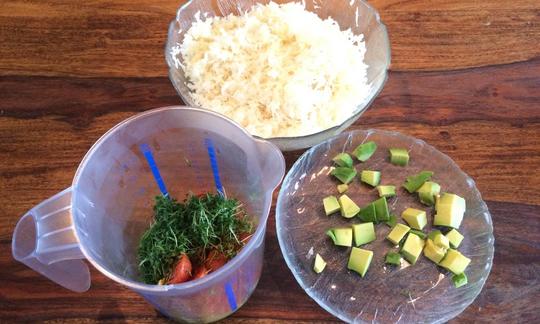Celery salad with avocado-tomato dressing
raw-vegan
Ingredients (for servings, )
| For the celery salad | |
|---|---|
| 26 oz | Celeriac, raw (organic?) |
| 3 ½ oz | Garden cress, raw (organic?) |
| 10 ml | Lemon juice (raw?, organic?) (0.36 oz) |
| ½ | Avocados, raw (organic?) (3.5 oz) |
| For the avocado-tomato dressing | |
| 5 | Cherry tomatoes, raw (cherry tomatoes, organic?) (3.2 oz) |
| ½ | Avocados, raw (organic?) (3.5 oz) |
| 35 ml | Lemon juice (raw?, organic?) (1.3 oz) |
| ½ tsp | Paprika powder, hot (raw?, organic?) (0.04 oz) |
| 4 dash | Table salt (table salt, raw?, organic?) (0.06 oz) |
| 2 dash | Black pepper (organic?, raw?) (0.01 oz) |
| For garnishing | |
| 1 sprigs | Coriander leaves, raw (0.08 oz) |
Equipment
- hand-held blender / immersion blender or blender
- grater or food processor
Type of preparation
- food preparation without heating
- blend
- peel
- grate (shred)
Preparation
For the celery salad
Peel the celery and cut into thin strips or grate them and sprinkle with lemon juice to keep them light in color.Wash the garden cress and chop finely, dice the avocado and add it to the celery strips along with the cress.
For the avocado-tomato dressing
Put the tomatoes, avocado, lemon juice, paprika powder, salt and pepper in the blender and puree until smooth. Add the cress and stir in.Garnish and Serve
Spread the dressing over the celery salad and garnish with freshly chopped coriander leaves.
|
Nutritional Information per person
Convert per 100g
|
2000 kcal | |
|---|---|---|
| Energy | 175 kcal | 8.7% |
| Fat/Lipids | 8.2 g | 11.7% |
| Saturated Fats | 1.2 g | 6.2% |
| Carbohydrates (inc.dietary fiber) | 25 g | 9.2% |
| Sugars | 5.4 g | 5.9% |
| Fiber | 7.4 g | 29.8% |
| Protein/Albumin | 4.8 g | 9.5% |
| Cooking Salt (Na:351.3 mg) | 892 mg | 37.2% |
| Essential micronutrients with the highest proportions | per person | 2000 kcal | |
|---|---|---|---|
| Vit | Vitamin K | 227 µg | 302.0% |
| Vit | Vitamin C (ascorbic acid) | 45 mg | 56.0% |
| Elem | Potassium, K | 1'033 mg | 52.0% |
| Sodium, Na | 351 mg | 44.0% | |
| Vit | Vitamin B9, B11 (Folate, as the active form of folic acid) | 82 µg | 41.0% |
| Elem | Phosphorus, P | 268 mg | 38.0% |
| Vit | Vitamin B6 (pyridoxine) | 0.53 mg | 38.0% |
| Min | Copper, Cu | 0.29 mg | 29.0% |
| Min | Manganese, Mn | 0.55 mg | 27.0% |
| Vit | Vitamin B5 (Pantothenic acid) | 1.5 mg | 24.0% |
Detailed Nutritional Information per Person for this Recipe
The majority of the nutritional information comes from the USDA (US Department of Agriculture). This means that the information for natural products is often incomplete or only given within broader categories, whereas in most cases products made from these have more complete information displayed.
If we take flaxseed, for example, the important essential amino acid ALA (omega-3) is only included in an overarching category whereas for flaxseed oil ALA is listed specifically. In time, we will be able to change this, but it will require a lot of work. An “i” appears behind ingredients that have been adjusted and an explanation appears when you hover over this symbol.
For Erb Muesli, the original calculations resulted in 48 % of the daily requirement of ALA — but with the correction, we see that the muesli actually covers >100 % of the necessary recommendation for the omega-3 fatty acid ALA. Our goal is to eventually be able to compare the nutritional value of our recipes with those that are used in conventional western lifestyles.
| Essential fatty acids | per person | 2000 kcal |
|---|---|---|
| Linoleic acid; LA; 18:2 omega-6 | 1.2 g | 12.0% |
| Alpha-Linolenic acid; ALA; 18:3 omega-3 | 0.08 g | 4.0% |
| Essential amino acids | per person | 2000 kcal |
|---|---|---|
| Tryptophan (Trp, W) | 0.01 g | 6.0% |
| Threonine (Thr, T, irreversibly transaminated) | 0.04 g | 5.0% |
| Isoleucine (Ile, I) | 0.05 g | 4.0% |
| Lysine (Lys, K, irreversibly transaminated) | 0.08 g | 4.0% |
| Phenylalanine (Phe, F) | 0.06 g | 4.0% |
| Valin (Val, V) | 0.06 g | 4.0% |
| Leucine (Leu, L) | 0.08 g | 3.0% |
| Methionine (Met, M) | 0.02 g | 2.0% |
| Vitamins | per person | 2000 kcal |
|---|---|---|
| Vitamin K | 227 µg | 302.0% |
| Vitamin C (ascorbic acid) | 45 mg | 56.0% |
| Vitamin B9, B11 (Folate, as the active form of folic acid) | 82 µg | 41.0% |
| Vitamin B6 (pyridoxine) | 0.53 mg | 38.0% |
| Vitamin B5 (Pantothenic acid) | 1.5 mg | 24.0% |
| Vitamin B2 (Riboflavin) | 0.25 mg | 18.0% |
| Vitamin E, as a-TEs | 2.1 mg | 18.0% |
| Vitamin B3 (Niacin) | 2.6 mg | 16.0% |
| Vitamin B1 (Thiamine) | 0.16 mg | 15.0% |
| Vitamin A, as RAE | 108 µg | 14.0% |
| Essential macroelements (macronutrients) | per person | 2000 kcal |
|---|---|---|
| Potassium, K | 1'033 mg | 52.0% |
| Sodium, Na | 351 mg | 44.0% |
| Phosphorus, P | 268 mg | 38.0% |
| Magnesium, Mg | 65 mg | 17.0% |
| Calcium, Ca | 111 mg | 14.0% |
| Essential trace elements (micronutrients) | per person | 2000 kcal |
|---|---|---|
| Copper, Cu | 0.29 mg | 29.0% |
| Manganese, Mn | 0.55 mg | 27.0% |
| Iron, Fe | 2.1 mg | 15.0% |
| Zinc, Zn | 1.1 mg | 11.0% |
| Selenium, Se | 1.8 µg | 3.0% |
| Fluorine, F | 4.1 µg | < 0.1% |
The celery salad with avocado-tomato dressing is a wonderfully fresh starter or side dish. The spicy celery harmonizes wonderfully with the avocado.
Celeriac: If you have a food processor, you can grate the celery more quickly. Celeriac will keep in the fridge for a good 14 days. You should wrap it in a damp cloth because the humidity in the vegetable compartment is usually not sufficient. If you decide to freeze the celeriac, you can extend its shelf life, but it will lose some of its flavor.
Avocado: The avocado has by far the highest fat content of all known fruits and vegetables. However, the fat is mostly unsaturated fatty acids, which have a positive effect on blood fat levels. In addition, the high proportion of indigestible fiber lowers cholesterol levels. Avocados also contain many valuable vitamins and minerals.
Avocados are climacteric fruits, meaning they continue to ripen. If you store avocados together with apples, you can speed up the ripening process by using the ripening gas ethylene that comes out of the apples. If the avocado skin gives way slightly when pressed, the fruit is ready to eat.
Paprika powder: There are different types of paprika powder, which can be differentiated by color and taste. The delicate and noble sweet varieties are slightly spicy and have a light to deep red color. Semi-sweet is much hotter than delicate and noble sweet paprika. Semi-sweet has a red-orange color. Rose paprika contains many seeds and ribs of the sweet peppers and therefore tastes even hotter than semi-sweet. The colors range from dark to yellowish red. The more intense the red color, the milder the taste of the paprika powder is as a rule.
Coriander: Opinions vary widely regarding the taste of coriander. Some people react to its intense, slightly soapy aroma with aversion or even nausea. According to statistics in Switzerland, 15% of all allergy sufferers are sensitive to coriander. In these cases, simply leave this ingredient out. However, it is the coriander that gives the dish its exotic note. There is no alternative with a similar taste. Flat-leaf parsley, which looks similar, has a completely different taste. Nevertheless, it is often used as a substitute.
Growing garden cress yourself: In the kitchen, cress seedlings are mainly used, which are harvested about a week after sowing. Garden cress tastes spicy and adds flavor to many dishes. The taste is slightly spicy and tangy.
Since garden cress does not take long to fully develop, you can easily grow cress yourself. Cress seeds begin to germinate at a temperature of around 5 °C. If you want to grow cress on the windowsill, sow the cress seeds evenly in shallow trays filled with soil. Alternatively, you can grow cress on damp kitchen paper or cotton wool. You can also grow cress in the garden from spring to summer.
Tomatoes: If you don't have fresh cherry tomatoes, you can also use regular ones. Because of their size, 1-2 tomatoes are enough as a substitute, but the resulting taste is less aromatic than cherry tomatoes.








